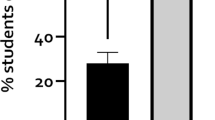Abstract
Although Business Ethics has become a topic of wide discussion in both academia and the corporate world, questions remain as how to present ethical issues in a manner that will effectively influence the decisions and behavior of business employees. In this paper we argue that the Federal Sentencing Guidelines (FSG) offer a unique opportunity for bridging the gap between the theory and practice of business ethics. We first explain what the FSG are and how they apply to organizations. We then show how discussions of the FSG might be used in business ethics courses in a way that is both theoretically sound and practically applicable. Finally, we show how the requirements of the FSG can be used by companies to develop effective ethical compliance programs. As such, we maintain that the FSG provide a powerful heuristic tool for the teaching and training of business ethics.
Similar content being viewed by others
References
Butterfield, K., D. McCabe andL. Treviño: 1998, 'The Ethical Context in Organizations: Influences on Employee Attitudes and Behaviors', Business Ethics Quarterly 8, 447-476.
Cleek, M. and S. Leonard: 1998, 'Can Corporate Codes of Ethics Influence Behavior?', Journal of Business Ethics 17, 619-630.
Cressey, D. and C. Moore: 1983, 'Managerial Values and Corporate Codes of Ethics', California Management Review 25, 53-72.
Dalton, D., M. Metzger andJ. Hill: 1994, 'The “New” U.S. Sentencing Commission Guidelines: A Wake-Up Call for Corporate America', Academy of Management Executive 8, 7-13.
Driscoll, D., W. Hoffman andJ. Murphy: 1998, 'Business Ethics and Compliance: What Management is Doing and Why', Business and Society Review 99, 35-51.
Ferrell, O., D. LeClair andL. Ferrell: 1998, 'The Federal Sentencing Guidelines for Organizations: A Framework for Ethical Compliance', Journal of Business Ethics 17, 353-363.
Monast, J.: 1994, 'What Is (And Isn't) the Matter With “What's the Matter... ”', Business Ethics Quarterly 4, 499-512.
Pamental, G.: 1991, 'The Course in Business Ethics: Why Don't the Philosophers Give Business Students What They Need?', Business Ethics Quarterly 1, 385-393.
Sanderson, G.: 1984, 'What's Wrong with Corporate Codes of Conduct?', Management Accounting 66, 28-35.
Shaw, W.: 1996, 'Business Ethics Today: A Survey', Journal of Business Ethics 15, 489-500.
Stark, A.: 1995, 'What's the Matter with Business Ethics?', Harvard Business Review 71, 38-48.
United States Sentencing Commission: 1991, 'Sentencing of Organizations', in Federal Sentencing Guidelines Manual (United States Sentencing Commission, Washington, DC), Chapter 8: http//www.ussc.gov/1994guid.
Author information
Authors and Affiliations
Rights and permissions
About this article
Cite this article
Palmer, D.E., Zakhem, A. Bridging the Gap Between Theory and Practice: Using the 1991 Federal Sentencing Guidelines as a Paradigm for Ethics Training. Journal of Business Ethics 29, 77–84 (2001). https://doi.org/10.1023/A:1006471731947
Issue Date:
DOI: https://doi.org/10.1023/A:1006471731947




